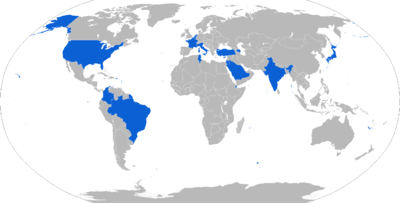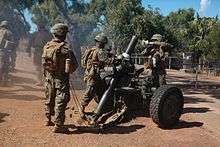Mortier 120mm Rayé Tracté Modèle F1
| Mortier 120mm Rayé Tracté Modèle F1 | |
|---|---|
 MO-120-RT-61 mortar | |
| Type | Heavy mortar |
| Place of origin | France |
| Service history | |
| In service |
French Army United States Marine Corps |
| Used by | France, among others (see below) |
| Wars |
Gulf War[1] War in Afghanistan Operation Serval |
| Production history | |
| Designer | Thomson-Brandt |
| Manufacturer | TDA Armements (France), Thomson-CSF/Daimler Benz Aerospace (Germany), Hotchkiss Brandt (Netherlands), MKEK (Turkey), Howa (Japan) |
| Produced | 1973 |
| Specifications | |
| Weight | 582 kg (1,283 lb) |
| Barrel length | 280 cm (9 ft 2 in) |
| Crew | 4 gunners, 2 vehicle crew |
|
| |
| Shell | 18.7 kg (41 lb) |
| Calibre | 120 mm (4.7 in) NATO mortar round |
| Carriage | wheeled |
| Elevation | 30–85° |
| Traverse | ±14° from centreline |
| Rate of fire | 6 to 10 rpm |
| Effective firing range |
8,140 m (8,900 yd) with standard projectile 12,850 m (14,050 yd) with rocket projectile |
The MO-120 RT-61 (factory designator) or MO-120-RT is a heavy mortar of French origin. The RT in the designator stands for rayé, tracté, which means rifled, towed.
The RT-61 is currently used by the French Army (where it is known as RT F1 or Mortier de 120mm Rayé Tracté Modèle F1—"120 mm rifled towed mortar, model F1"), and is produced under licence by Germany, Italy, Belgium, the Netherlands, Brazil, Japan and Turkey (as HY-12 "Tosam"[2]). The MO-120 RT-61 is issued to artillery units, where it augments the 155 mm towed artillery.
In French service, this weapon is normally towed by the VTM 120 (Véhicule Tracteur Mortier de 120 mm), a wheeled armored vehicle that is a derivative of the VAB 4x4 series of armored personnel carrier. Towing is accomplished by a towing hitch that is screwed onto the muzzle of the weapon. The VTM 120 also carries 70 rounds for the mortar and offers basic ballistic protection from small arms fire and shrapnel for the crew. The RT-61 can also be towed by the AMX-10 TM (Tracteur de Mortier), which is a version of the AMX-10P tracked APC. The Japan Ground Self-Defense Force have a self-propelled version of the RT-61 with 50 rounds, the Type 96.
The mortars, which originally equipped infantry regiments, have now all been transferred to the artillery regiments, where they augment the 155 mm towed artillery. Currently, there are eight 120 mm mortars assigned to each French Régiment d'Artillerie - although they are not deployed during peacetime.
The RT-61 uses standard NATO rounds as well as the specially designed PR-14 (HE) and the PRPA (HERA). The weapon can be fired either by dropping the round down the tube (after aligning of the rifling bands) resulting in an automatic firing once the bomb hits the tube base, or by a controlled firing by dropping the bomb down the tube and pulling on a lanyard that will in turn set off the triggering mechanism in the base of the tube.
Rounds fired from the mortar can reach as high as 8,000 ft (2,400 m) and hit the ground with an effective kill radius of nearly 250 ft (76 m).[3]
Manufacturers other than Thomson-Brandt as mentioned above include Thomson-CSF/Daimler Benz Aerospace (France/Germany(?)), Hotchkiss Brandt (Netherlands) as the "HB Rayé" and under license by MKEK in Turkey.
EFSS
The United States Marine Corps began looking for an Expeditionary Fire Support System (EFSS) in 2001 after the start of operations in Afghanistan exposed their lack of expeditionary artillery lighter than a 155 mm howitzer but heavier than a 60 mm mortar. Early on, the weapon became tied to the development of the MV-22 Osprey, which would contain a Growler ITV jeep that would tow it; both efforts were troubled and experienced delays. The EFSS was first used operationally in Afghanistan in February 2011, firing an M1105 illumination projectile.[4] The full EFSS was introduced in 2009, consisting of two light vehicles, one towing the mortar and the other an ammunition trailer, that fit inside an MV-22 or CH-53E Super Stallion; an EFSS battery is made up of roughly 50 Marines.[5]
From 2011 to 2015, the Marines and Raytheon developed the precision extended range munition (PERM) for the EFSS, a GPS-guided round that delivers greater range and better accuracy. The 35 lb (16 kg) round increased range from 8 km (5.0 mi) to 16 km (9.9 mi), falling within 10 meters of the target and as close as two meters, costing $18,000 each, and having 2.5-3 times more lethality. The extra range came from tail fins for stabilization and canards near the nose to make in-flight adjustments and make it glide as it descends, and the greater lethality was a result of this flight path; normal artillery rounds impact at a 45 degree angle, which blows the top half of the round straight up into the air, but descending at a sharp angle places more energy and fragmentation directly on a target. It was even capable of hitting reverse slope positions by shaping its trajectory. Greater accuracy also reduces logistical burdens, as using fewer rounds to destroy one target means a unit can last longer without needing resupply. The PERM was to begin fielding in 2018. Raytheon planned to add semi-active laser (SAL) guidance to PERM rounds to enable them to hit moving targets.[6][7][5][8]
By December 2017, the U.S. Marines had divested the EFSS. With the Marines working to extend the range of their artillery arsenal, the EFSS' limited range was not seen as well suited for future missions, so it was chosen for divestment in favor of moving more resources for precision fires.[9]
Operators


.svg.png)
















Variants
- MO-120-LT—This is a smooth-bore version for the mountain artillery.
Gallery
 M327 mortar rifling
M327 mortar rifling M327 mortar sight
M327 mortar sight- Towed configuration in Japanese service. Prime mover is Toyota Mega Cruiser
%2C_lowers_a_mortar_to_the_deck_of_amphibious_assault_ship_USS_Bataan_(LHD_5).jpg) USMC M327 mortar air lifted onto USS Bataan amphibious assault ship
USMC M327 mortar air lifted onto USS Bataan amphibious assault ship USMC M327 being loaded into tracked vehicle
USMC M327 being loaded into tracked vehicle USMC High explosive 120mm round showing rifling.
USMC High explosive 120mm round showing rifling. M327 120mm Rifled Towed Mortar ready to fire in training exercise
M327 120mm Rifled Towed Mortar ready to fire in training exercise JGSDF version Type 96 Heavy mortar
JGSDF version Type 96 Heavy mortar
See also
- Cardom 120 mm recoil mortar system
- Soltam K6 120 mm mortar
- Soltam M-65 120 mm mortar
- 120 KRH 92 120 mm mortar
- 120mm M2 RAIADO 120 mm mortar
- 2S12 Sani 120 mm mortar
References
- ↑ Rottman, Gordon L. (1993). Armies of the Gulf War. Elite 45. Osprey Publishing. p. 46. ISBN 9781855322776.
- ↑ http://articles.janes.com/articles/Janes-Infantry-Weapons/MKEK-120-mm-HY-12-mortar-Turkey.html
- ↑ TBS Marines Witness EFSS Mortar's Impact - Marines.com, 12 September 2014
- ↑ Marines Finally Fire Their Osprey Mortar - Kitup.Military.com, 20 February 2011
- 1 2 Marines introduce deadly new mortar round - MarineCorpstimes.com, 16 December 2015
- ↑ Guided mortar rounds have 20-kilometer range - MarineCorpstimes.com, 2 February 2013
- ↑ Marines to Receive Precision-Guided Mortar Round in 2018 - Military.com, 16 December 2015
- ↑ Raytheon, IMI to Provide Guided Bombs for Marine Corps Mortars - Defense-Update.com, 10 December 2015
- ↑ Marine Corps Ditches Towed Mortar System in Push to Fund Modernization - Military.com/DoDBuzz.com, 19 December 2017
- ↑ http://www.defenseindustrydaily.com/EFSSITV-The-US-Marines-Mobile-120mm-Mortar-System-06756/
External links
| Wikimedia Commons has media related to MO-120-RT-61. |
| Wikimedia Commons has media related to EFSS. |